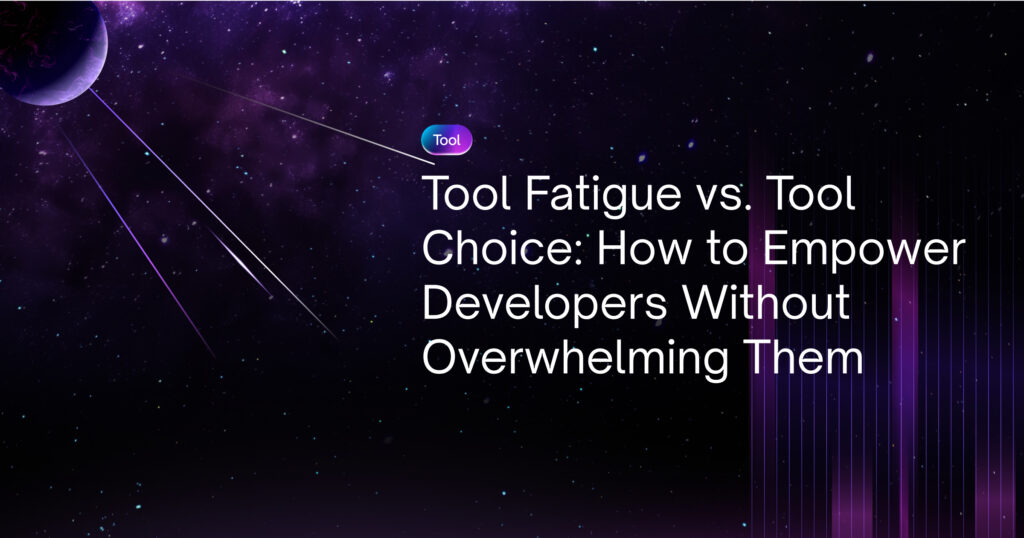
Introduction: When Tooling Choice Becomes Operational Overhead
What starts as smart tooling decisions picking the best CI system here, an observability platform there often snowballs into a fragmented stack. Each tool solves a specific problem, but collectively they introduce friction, duplicative effort, and cognitive overload. Developers lose time to configuration, troubleshooting, and context switching.
This isn’t just a tooling issue, it’s a developer experience problem. When navigating the stack becomes a prerequisite for shipping code, productivity stalls and morale drops. In this post, we unpack how teams can balance autonomy with simplicity, and how platforms like Revolte help reduce operational overhead without compromising flexibility.
The Line Between Tool Choice and Tool Fatigue
Modern engineering thrives on autonomy, but left unchecked, that autonomy can devolve into cognitive overload. Developers want the freedom to use tools that fit their workflows, but when every choice requires manual integration, specialized knowledge, or constant upkeep, the experience becomes counterproductive.
- Tool choice empowers teams by supporting flow, focus, and flexibility.
- Tool fatigue arises when each new tool adds overhead rather than value.
Why Tool Fatigue Is Especially Prevalent in DevOps
Tool fatigue isn’t caused by bad tools, but by the accumulation of narrowly scoped decisions made in fast-moving environments. DevOps, in particular, is vulnerable due to the pressure to integrate quickly and scale reliably.
- Best-of-breed overload: Choosing the ideal tool for every layer often results in teams maintaining the glue between them.
- Lack of paved paths: In the absence of standardized patterns, teams end up improvising, leading to brittle, divergent workflows.
- Fragmented failure modes: Each tool introduces unique alerting behaviors and diagnostic challenges, increasing on-call load.
Recognizing Tool Fatigue in Your Stack
You may be facing tool fatigue if any of the following sound familiar:
- Developers require multiple dashboards or tabs to trace a deploy.
- Alerts are duplicated or contradictory across different systems.
- New engineers spend days configuring tools instead of contributing.
- Platform teams are consumed by reactive support instead of strategic improvements.
When Tooling Freedom Helps and When It Hurts
Tooling isn’t the enemy. But ungoverned sprawl is.
Here’s a simple decision lens you can use:
- Strategic choice: Does this tool solve a real problem more effectively than existing solutions?
- Incidental complexity: Are we using it because something else was misconfigured, or undocumented?
How to Start Fixing Tool Fatigue
Addressing tool fatigue doesn’t start with buying new software. It starts with introspection and systems thinking. Here’s how teams can begin untangling complexity without sacrificing control:
- Map the full path from code to production
Inventory every tool, script, and handoff involved in delivering a change. Identify overlaps, bottlenecks, and areas of repeated manual effort. - Look for “glue work” hiding in plain sight
Notice where developers are acting as integration layers, manually syncing configs, resolving pipeline mismatches, or stitching together alerts. - Establish golden paths, not golden cages
Build strong defaults that work for 80% of use cases. Offer escape hatches for edge cases, but don’t make every engineer build their own path from scratch. - Treat internal developer experience like a product
Invest in docs, automation, and observability. Make onboarding smooth, changes traceable, and tooling invisible when it’s working. - Audit your stack through a simplicity lens
If a tool needs its own dashboard, onboarding session, and troubleshooting playbook, it may be costing more than it’s worth.
How Revolte Eliminates Fatigue Without Sacrificing Control
At Revolte, we believe the best developer platforms don’t over-engineer freedom, they enable it through thoughtful defaults and seamless integration.
Instead of layering more tools onto your stack, we provide a unified, extensible platform that simplifies delivery without reducing control:
- Consistent, one-click deployments, so developers don’t need to script around gaps
- Integrated observability, logs, metrics, and traces without vendor sprawl
- AI-optimized pipelines, intelligent CI/CD tuned to your repo
- Security and compliance baked in, not bolted on
- Transparent, usage-based pricing, encourages consolidation, not lock-in
We don’t eliminate choice. We eliminate chaos.
From Sprawl to Strategy: A Quick Developer Experience Audit
Ask yourself and your team:
- Are multiple tools solving the same function with conflicting outcomes?
- Can a new developer follow a deploy end-to-end within an hour?
- Is your team investing in scalable workflows, or maintaining duct tape?
- Are your platform engineers building enablement, or firefighting integrations?
If these questions expose friction, your developer experience is holding you back and fixing it is a competitive advantage.
Conclusion: Developer Experience Is a Strategic Asset
Tool choice should accelerate delivery, not obstruct it. Without clear experience design, even the best tools become burdens. As stacks grow, intentional simplicity becomes the differentiator.
The next generation of engineering teams won’t win by stacking more tools. They’ll win by designing platforms that are focused, flexible, and fast.
Revolte helps you build that kind of system, so your developers can stay in flow, not in the weeds. Start your journey with Revolte